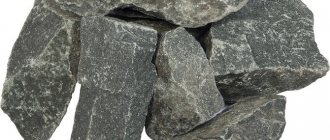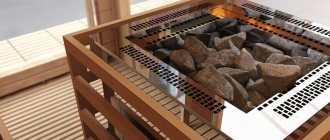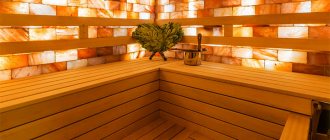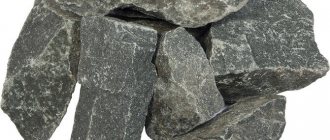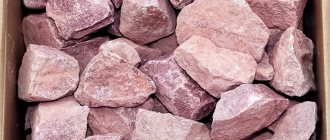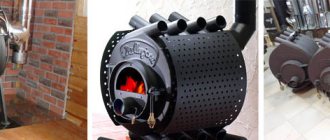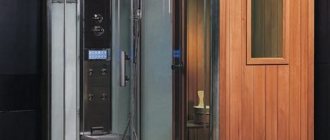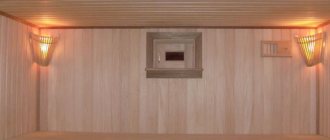Gabbro-diabase
We have made an attempt to thoroughly answer the question: what is gabbro-diabase, to consider all its properties and characteristics. The result of the work done was this section. If you don’t want to get acquainted with its subject so completely, look only at the subtitle that interests you.
Physical properties of gabbro
The color is dark, dark green, black. The structure is coarse-grained, medium-grained. The texture is mottled, banded or massive. Specific gravity 2.76-3.27 g/cm3. Hardness 6-7 on the Mohs scale. The melting point reaches 1250ºС. The compressive strength is on average 280 MPa.
Features . Gabbro is characterized by a granular structure, containing mainly feldspar and pyroxene, the absence of quartz, dark color, and high density. The stone can be confused with diorite. The difference is that it is heavier than diorite, contains more dark-colored minerals and has a darker color.
What is gabbro-diabase
The name is unusual, complex, and tells little to a person who is far from geology. At the same time, traders actively use it, leaving clients to find out for themselves what kind of stone it is.
Mineral or rock
We already know that it is a stone, but stones are divided into two categories: minerals and rocks. The difference between them is that rocks are a frozen mixture of crystals or amorphous forms of several minerals at once.
That is, a mineral is a structural unit. It can be presented in its pure form - including very large crystals, for example. Or it can be part of a rock, where it will coexist with other minerals, without mixing, but also without separating from them.
Gabbro-diabase is a rock. It is composed of several minerals, and they can also be represented by varieties, but in the most general sense it is the main plagioclase and pyroxenes (augites of variable composition). Therefore, it cannot be called a “mineral”.
Gabbro and gabbro-diabase - what is the difference
Answering the question what is the difference between gabbro and gabbro-diabase is both simple and difficult. The difficulty is due solely to the confusion that still exists in official geology and the habits of miners and sellers of finished stone products.
To answer simply, then Mr. - this is the same gabbro, but only the minerals that originally composed it were replaced by others: say, plagioclase was replaced by saussurite, and instead of augite, one of the following options appeared: epidote, hornblende or chlorite. The product of replacement of paleotype rock is called “diabase”; if it was replaced by gabbro, then “gabbro-diabase”.
dolerite is also called “diabase” - it is a cenotype rock that has not undergone any replacement. It differs from gabbro only in the depth of its formation. Let us explain: the source for all of them is the basic magma (we are talking about alkalinity), which contains silica (silicon oxide) in amounts up to 52%.
If this magma flows into cavities at a depth of over 3 km, then there it slowly crystallizes as it cools, and gabbro is obtained.
If the same thing happens at a depth of less than 3 km, then crystallization may be incomplete (in particular for augite), and this is how dolerite is obtained.
Well, if magma managed to flow onto the surface, then it solidifies much faster there, quickly loses various gaseous fluids, and the result is basalt.
Please note: this is the same magma, only solidified under different conditions (with some differences in structure and composition).
Therefore, those who are interested in the question of the difference should first clarify what we are talking about: dolerite or diabase.
This difference makes no difference to miners, and even more so to stone sellers. They generally consider these rocks... granite. So if you want to get to the bottom of the truth, ask for a certificate, it is issued by geologists, and they call a spade a spade.
Why is it useful?
The question is, of course, strange. What benefits are we talking about: for an individual or for the national economy? Let's try to go through all the applications.
Gabbro-diabase sauna stones, crushed. Photo by Leroy Merlin
So, how is gabbro-diabase useful in construction? It has excellent compressive strength, so it has proven to be extremely useful for road construction, where it is used in the form of road cushions (crushed stone), paving stones, and paving slabs. The same properties are in demand when constructing foundations, so it is placed in the solution as a filler.
Polished stone has found application in construction and in the construction of monuments - it is used to make facing tiles, staircase parts, balustrades, window sills, as well as tombstones, obelisks and other memorial and ritual products. This is due to the rich color, the durability of the polish, and, in general, the longevity of the stone.
It is also useful in the household - it is the cheapest filler for a heater in a sauna stove, but its performance is better than that of quartzite and other stones from a more expensive category. By the way, you can read about using it in a bathhouse.
"Healing properties"
By the way, in connection with the bathhouse, the question of the healing of stones often arises. But we are of the opinion that gabbro-diabase has no healing properties. Just like other stones.
More precisely, not quite like that: we leave it to shamans and healers to know the healing properties of stones, plants and animals - they have experience, tradition. But buy a box of stones in a store, put them in the heater and expect them to mysteriously begin to fulfill everything that the bathhouse owner was promised on the Internet... no, you can only convince yourself of this.
Flaws
Gabbro-diabase slab. Photo Karelian gabbro-diabase
If we talk about advantages, then there must be disadvantages. What are the disadvantages of gabbro-diabase?
If the stone is normal, without cracks, without admixtures of iron ores or sulfur compounds , then it does not have any special disadvantages. Strength and durability are higher than that of granite, so wherever you put it - even on the road, even in the stove - it works regularly in its place.
In general, for its purposes (described above) it is a good choice. It will not survive jadeite in a closed heater, but its price is such that you can buy a wagon with the amount of jadeite. The color range is limited, but for monuments black is the most suitable color. And so on.
Common Questions
Is it possible to mix gabrodiabase with another stone?
It is possible, but soap chloride in this case will slightly reduce its heating.
I bought gabrodiabase, six months later I went into the heater, and there was sand and small crushed stone. What does it mean?
This happens when there is excessive overheating and active watering. This may also indicate low quality stone.
I put gabro-diabase in the heater, and it emits a rather pungent smell of sulfides. They are not visible from the outside. Is it possible to somehow remove these impurities?
When selecting and purchasing, special attention is required to stones that are brought from Karelia. They are completely “impregnated” with sulfides. Carry out 3 – 4 idle fires at high temperatures. If the smell persists, the stone will have to be removed from the heater and used for other purposes.
Is it possible to use gabbro-diabase with a red coating that appears on wet stone?
Red plaque is usually iron oxides on the surface of the stone; they are harmless. But too many red-brown spots may indicate that we have pyroxene or hornblende.
I was going through my heater and found a whitish coating on the gabbro-diabase, which is difficult to remove. Isn't this dangerous?
A dense whitish coating is the release of carbonate rock under the influence of water. It is safe for health and should not be considered as a stone defect.
Are there any contraindications to the use of gabbro-diabase in a bath?
The concept of “contraindications” is medical and is associated with the healing benefits of stones. In the bathhouse, they play exclusively the role of heat accumulation and transfer. In this sense, it is contraindicated to use, for example, marble or granite, because they will not withstand periodic heating and cooling. The heart and blood vessels are much more influenced by the ratio of temperature and humidity in the steam room than by the type of stones in the oven. So don’t complicate what’s simple and calmly put high-quality gabbro-diabase into the heater; it has absolutely neutral effects on the human body.
How to mine
Development of gabbro-diabase deposits can be carried out using a variety of technologies. Most often, to extract this material, a hole is first drilled into the rock. Further into it to break the stone can:
- planting explosives;
- pump air under pressure;
- water is supplied and wooden pegs are hammered in (which, swelling, tear the stone).
Gabbro-diabase can also be divided into pieces using, of course, a stone cutter. This technology is currently considered the most expensive and labor-intensive. But at the same time, using it you can extract the highest quality stone.
The unique Karelian gabbro-diabase is currently considered the best in the world. And the deposit itself in this region is one of the largest in the world. The reserves of this type of diabase in Karelia are no less than 4 million m3.
Australian stone is also considered a fairly high-quality material. Its properties are close to Karelian. However, this breed, unfortunately, is much more expensive. The price of Australian diabase is almost three times higher than Karelian diabase.
What is the breed
As you can already judge from the name, this stone is a “transitional” link between diabase and gabbro. According to its characteristics, the rock is close to basalt and granite. It is a gabbro-diabase stone of a dark gray or greenish color. It contains, for example, minerals such as:
- titanomagnetite;
- plagioclase;
- pyroxenes;
- amphiboles.
None of these types of minerals release harmful substances into the air. And this is, of course, a big advantage of gabbro-diabase as a stone used in industry, construction and everyday life.
Advantages and disadvantages
- The main advantages of gabbro-diabase for baths are high thermal conductivity combined with a very affordable price. The flattened shape is convenient for placing in the oven.
- One of the disadvantages is that it takes a long time to heat up. In addition, if this breed is exposed to too high temperatures, it begins to emit an unpleasant odor. Decoctions and herbal elixirs cannot be poured onto gabbro-diabase. A persistent soot immediately forms on the surface.
Reference! Advanced bath attendants complain about the simple and “flat” steam obtained from gabbro-diabase: it is not as voluminous and refined as from the same jadeite. There is no dispute about taste, but the attractive price of the mineral makes it a very good choice for inexperienced users and beginners.
Flakiness
Flat or needle-shaped crushed stone grains are called flakied grains. They are formed during the crushing process of rock. The more of them there are in a material, the lower its bulk density. Flaky particles collapse faster under loads than cube-shaped crushed stone. Therefore, material with a high index should not be purchased for foundations and road surfaces. But it has excellent drainage properties. Crushed stone is suitable for filling pipes through which water is drained from the site.
There are 5 groups of flakiness:
- – up to 10% flakier grains
- – 10-15% inclusions
- – 15-25% flake particles
- – 25-35% flat grains
- – 35-50% inclusions
In the Yekaterinburg region, crushed gabbro of flaky groups 1-4 is found. Before purchasing, check the indicator in the test report (this can be requested from the supplier). If you need material for backfilling drainage, take group 3-4. Only groups 1 and 2 are suitable for the foundation, and 1-3 for backfilling the yard.
Description of the rock
Below we will consider in detail a number of physical-mechanical, chemical and mineralogical characteristics of this stone. For almost all of them, there are test methods described in GOST and average values within a particular class. We will definitely compare the characteristics of gabbro-diabase with the standards for the class of rocks to which it belongs.
Origin
We have already said above that the origin of gabbro-diabase is magmatic. In fact, many rocks have this origin; it is one of three possible origins for any stone.
In magmatic origin, it is customary to distinguish two main factors:
- the amount of silica, which determines the acidity or basicity of the rock;
- depth of melt solidification .
According to these criteria, gabbro-diabase is the main rock, with a silica content of up to 52%, and according to the depth of formation, it is hypabyssal, which affects its fine-crystalline structure.
Chemical composition
We must understand that the chemical composition and mineral composition are interdependent things, but at the same time, from the chemical composition alone we cannot complete the idea of what a given rock is.
Let's say oxides are the chemical basis of the vast majority of stones. However, exactly how the atoms of different elements are arranged in the crystal lattice of a mineral has a great influence on its appearance and properties.
In other words, if you took the chemical compounds that make up this or that stone in their pure form and mixed them, you would not get any stone. Which, in fact, is true of the chemical composition of a person or anything.
Below is the approximate chemical composition of gabbro-diabase, with variations in the percentage of each component:
| SiO₂ | 43-52 %, |
| Al₂O₃ | 8-27 %, |
| Fe₃O₄ | 1,8-25 %, |
| CaO | 8-18 %, |
| MgO | 3-15 %, |
| ТіО₂ | 0,1-4 %, |
| Na₂O | 0,5-3,5 %, |
| K₂O | 0,05-2 %. |
physical characteristics
Let's move on to the physical characteristics of gabbro-diabase. Most of them are prescribed in GOST standards.
Radioactivity
The level of radioactivity allowed in building construction and road construction varies. Regulatory documents for both are also different. For buildings, you need to look at the “Radiation Safety Standards NRB-76” (Appendix 2). And what relates to road and industrial construction is standardized in the “Methodological recommendations for radiation-hygienic assessment of building materials.
Gabbro-diabase slab. Photo Green Time
If the specific effective activity of radionuclides is less than 370 Bq/kg, the building material is assigned class I, and it can be used in all types of construction (residential, industrial and road). This standard is described in Appendix A to GOST 30108-94 “Construction materials and products. Determination of the specific effective activity of natural radionuclides (with Amendments No. 1, 2).”
As for the radioactivity of gabbro-diabase, it is always low , but specific values should be in the document issued to the deposit developer by the laboratory.
Values less than 370 Bq/kg are found online (for example, 300 Bq/kg, 57 Bq/kg, 59 Bq/kg).
Density
With density , not everything is as simple as it seems. The standards distinguish several types of research, depending on the researcher’s tasks.
Density of gabbro-diabase kg/m3
Typically, density refers to the ratio of mass to volume. This applies to massive homogeneous bodies. The reference value for gabbro-diabase density in kg/m3 is 3070.
True density of gabbro-diabase
If we are talking about bulk material, for example, crushed stone, then the appearance of voids between its elements is inevitable, which affects the value of volume measurement.
When the volume of voids is included in the volume of crushed stone, the result is “average density”. When the calculation is made for an absolutely dense material, without voids or pores, this is called “true density”.
How exactly the calculations are carried out can be found in GOST 33057-2014 “Public road roads. Crushed stone and gravel from rocks. Determination of average and true density, porosity and water absorption (with Amendment).”
On a website selling Karelian gabbro-diabase, the following information was found:
The true density of gabbro-diabase is 0.65 g/cm3.
Average density - 3.06 g/cm3
And the directory says that its “true density is 2.8-3.0 g/cm3 .” We believe that the sellers made a mistake in the description.
Bulk density of gabbro-diabase
In essence, this is the same average density, but adjusted for the fact that the material has not been compacted.
The need to introduce an almost synonymous concept is due to the fact that crushed stone can be sold both in tons and in cubic meters. To be able to estimate the mass from the volume and vice versa, take the ratio of the mass of uncompacted crushed stone to the volume it occupies. This indicator is not considered by the standards.
Crushed stone from gabbro-diabase. Dune Photos
The bulk density of gabbro-diabase (crushed stone) ranges from 1.47 to 1.55 t/m³.
Melting point of gabbro-diabase
The melting point of gabbro-diabase is 1250 degrees .
Heat capacity of gabbro-diabase
The heat capacity of gabbro-diabase is 0.8 kJ/kg . Jadeite has 0.88.
Hardness
The hardness of gabbro-diabase can be measured in different ways. However, for minerals the Mohs scale is still the most used .
Gabbro-diabase: Mohs hardness
The hardness of gabbro-diabase on the Mohs scale is 6-7.
Specific gravity
Attention! Don't confuse specific gravity and density.
Specific gravity is the ratio of weight to volume. Weight differs from mass by the magnitude of the acceleration due to gravity. For minerals, specific gravity is calculated as the ratio of the weight of the mineral to the weight of the water it displaces (that is, the volume of water it occupies).
The specific gravity of gabbro-diabase is about 3 g/cm3 .
Properties visual
Gabbro-diabase paving stones. Photo Green Time
A description of the gabbro-diabase rock would be incomplete without mentioning its visual properties. color and in this category .
In general, there is a GOST for scoring decorativeness. Which consists precisely of the correspondence of the rock to our human ideas about what is beautiful in it - bright, rich color, interesting texture.
Gabbro-diabase may well have a rich color, but it is not very lucky with its texture - it is small and inexpressive. But this is compensated by the fact that it is a fairly durable stone.
Texture
The certificate given above gives the petrographic characteristic of the gabbro-diabase texture - “massive”. This means that the minerals that make up the rock are evenly distributed in it. However, this is visible to the naked eye.
In general, on sale you can find gabbro-diabase with varying degrees of gray hair. This usually refers to the inclusion of small, light-colored crystals that contrast with the dark mineral, creating a pattern similar to gray hair showing through. When there is a lot of it, gabbro-diabase takes on an overall dark gray color. When a little - noble black.
It was said above that gabbro-diabase includes plagioclase and augite. The first is light, the second is dark. Plagioclase crystals are better formed than those of augite, which fills the space between them.
Color
In addition to black “gray-tinged”, you can find greenish varieties of gabbro-diabase.
Photo: black gabbro-diabase
Black gabbro-diabase. Photo Green Time
Photo: green gabbro-diabase
Lump of green gabbro-diabase
Gabbro-diabase green: block. Rodna Photos
Gabbro-diabase green.
Scope of stone application
Gabbrodolerite is widely used:
- In road construction. Stone is used to make checkers, paving stones, curbs, and to strengthen slopes, ditch walls, trays, and to pave squares, sidewalks, and public gardens. The material is resistant to abrasion and mechanical stress.
- In civil engineering it is used as plinth stone and rubble. Polished and heat-treated tiles are produced from gabbro-diabase for decorative cladding. Interior decoration includes the creation of staircase steps, railings, window sills, bathrooms and kitchens.
- For sauna stoves. Due to the fact that natural material heats up perfectly, first accumulating heat and then releasing it, gabbro-diabase is used in the construction of baths and saunas.
- In landscape design of parks, public gardens, personal plots. Black oblique boulders and cobblestones are laid on green lawns or included in colorful alpine slides.
Part of the gabbro is used for the production of crushed stone of various fractions, which is produced using modern technologies and is widely used in industrial, civil and road construction.
Gabbrodolerite is a durable stone of natural origin with visual appeal. The qualities of gabbro allow this mineral to be used in various fields. Diabase stones are used for paving streets and squares. Red Square in Moscow and the lobby of the Chernaya Rechka metro station in St. Petersburg are paved with Karelian rock. In what other areas is this mineral used? The fossil is also used:
- in architecture as an independent material or base stone;
- in the production of crushed stone, rubble;
- in the manufacture of decorative items (sculptures, engravings);
- in the production of tombstones;
- in precision engineering;
- in heaters of bathhouse or sauna stoves.
The amulet, made of gabbro material, gives its owner physical endurance and performance. This stone exhibits its magical properties only in strong-willed, active, purposeful people. It will not be of any use to weak and uninitiated individuals. At the same time, the owner of the amulet must believe in its power.
Production
On our website there are articles that are devoted to the extraction of gabbro-diabase - this is material about the deposits (with addresses) and an article about the extraction and processing of this stone.
You may also be interested in materials about a variety of products that are made from it (including monuments) and what can replace gabbro-diabase in a bathhouse, in construction or in the manufacture of a monument.
Frost resistance
The volume of ice is always greater than the volume of water. If moisture enters small cracks and freezes there, it expands them, and the stone gradually collapses. The ability to resist such a process is called frost resistance.
The indicator is closely related to strength. The higher the crushability grade, the better the breed tolerates numerous cycles of freezing and defrosting. Crushed gabbro has a frost resistance of F200-F300. If we consider that in one winter temperature changes from plus to minus occur 5-6 times, then a coating made of such material will last 50-60 years.
Selection rules
When choosing gabbro-diabase for use in a heater, pay attention to the following key points:
- At the fracture, the structure should be as fine-crystalline as possible. Large grains indicate low strength, and such a specimen will quickly collapse when heated.
- Examine the structure using a magnifying glass for microcracks. When heated, they will begin to rapidly increase in size until the stone turns into dust.
- The body of the mineral should not contain a large number of inclusions of quartz. If this is observed, you are offered not gabbro-diabase, but some other rock.
- When struck, the stone should respond with a clear, transparent and elastic sound. A dull, annoying echo indicates the presence of hidden defects in the thickness.
- Form. In a closed heater, rounded stones will behave better, because there is always a little space between them, enough for water to flow inside. In the open, split gabbro-diabase is preferred for more dense installation.
- Many varieties of gabbro-diabase contain increased amounts of sulfides. Visually, they look like a scattering of small crystals with a mirror-like silvery or less often golden sheen. When heated, sulfides will break down and release a pungent odor, which will cause a sore throat and stinging in the eyes. The decomposition of sulfides can take quite a long time, so such a stone should be discarded.
- To test for strength, knock 2 stones together or hit them with a hammer. There is another indicative way to check the suitability of a stone. Heat it until red hot and immediately plunge it into cold water. If cracks or splits do not appear, you can safely use the stone in steam rooms and baths.
- Availability of a certificate. You should not collect any stones yourself in unverified places, near railways or in close proximity to industrial facilities. The stone tends to absorb various microparticles and odors, which can subsequently affect the quality of the supplied steam, and in some cases even pose a health hazard.
For your information! Domestic varieties of gabbro-diabase fully meet the basic requirements of a bath attendant and at the same time have an affordable price. The purchase of a more expensive Finnish stone is justified only by a better selection of stone and the absence of harmful sulfites in its array, which is often the case with Karelian analogues.
Comparison with granite
The two breeds have similar physical characteristics. Sometimes gabbro-diabase is even considered a type of granite. However, this is, of course, not at all true. These two breeds differ in the following characteristics.
- By origin. Gabbro-diabase is a volcanic rock. It is found quite rarely on our planet. Granite is formed at great depths under the pressure of the upper layers. This stone has a layered structure.
- By appearance. Granite is characterized by a huge variety of colors. Gabbro-diabase, unfortunately, is inferior to it in this regard.
- According to physical properties. Granite is harder than diabase. But at the same time it is not so durable. In addition, diabase is significantly superior to granite in terms of wear resistance.
Gabbro-diabase has a unique structure - completely crystalline, which makes it practically impenetrable to water. It is this rock that has the lowest percentage of moisture absorption among all known on the planet.
Water resistance
If the rock contains few soluble salts, it is highly water resistant. To determine the indicator, the sample is dipped into liquid and kept there for 24 hours. Before and after testing, the crushed stone is weighed. With water resistance rating B1, it loses up to 1% of its mass, with B2 - 1-3%.
High water resistance is characteristic of durable crushed stone made from igneous rocks. If its crushability grade exceeds M600, then the indicator will be B1. Crushed gabbro has a strength exceeding M1200, which means it is poorly soluble in water and has a water resistance grade of B1. Swamps are filled with this material and underwater structures are strengthened.
Content of dust and clay particles
These are small particles formed during the crushing of rock. Clay more often gets into the material when extracted from the surface of quarries. Small impurities impair adhesion, drainage properties, and increase water absorption. With a significant clay content, it swells and heaves, which leads to deformation of coatings and cushions under the foundation.
According to GOST, the figure should be less than 1%. For crushed gabbro from the Sverdlovsk region it is generally close to zero, only for the 15-20 mm fraction it exceeds the permissible standards (up to 2%).
Application area
Gabbrodolerite is a durable stone of natural origin with visual appeal. The qualities of gabbro allow this mineral to be used in various fields. Diabase stones are used for paving streets and squares. Red Square in Moscow and the lobby of the Chernaya Rechka metro station in St. Petersburg are paved with Karelian rock. In what other areas is this mineral used? The fossil is also used:
- in architecture as an independent material or base stone;
- in the production of crushed stone, rubble;
- in the manufacture of decorative items (sculptures, engravings);
- in the production of tombstones;
- in precision engineering;
- in heaters of bathhouse or sauna stoves.
Gabbrodolerite has medicinal properties. The stone has a positive effect on the genitourinary system, improves liver function and stabilizes the state of mind. Smooth, unprocessed minerals are used in stone therapy when heated. There are some contraindications to this procedure, so you should consult your doctor before undergoing it.
The amulet, made of gabbro material, gives its owner physical endurance and performance. This stone exhibits its magical properties only in strong-willed, active, purposeful people. It will not be of any use to weak and uninitiated individuals. At the same time, the owner of the amulet must believe in its power.
Properties according to standards
The standards describe the properties not of gabbro-diabase stone, but of rocks in general according to where they are used, which is correct, in general - you cannot write standards for every stone.
GOST
GOST standards for gabbro-diabase refer to two areas - rock blocks crushed rock.
At the same time, the blocks relate to both construction and the manufacture of ritual products, that is, there is only one GOST for blocks, but with crushed stone the situation is different - a lot of regulatory literature has been discovered on the following areas of application:
- public roads;
- railways;
- construction works.
In order not to clutter the article, we have created a pdf file that you can download and review. There is only a list, but there is a link to the site where the full texts are published.
GOST crushed stone
Blocks of gabbro-diabase. Photo Green Time
GOST for blocks has the number 9479, there is an edition of 98 and 2011:
- GOST 9479-98
- GOST 9479-2011
Briefly, what is standardized in this document. This is an interstate standard for a number of CIS countries, in force in them, in addition to Russia. Applies to everything that can be made from a block of stone of different types.
The blocks themselves are evaluated according to indicators and characteristics, grouped as follows:
- physical and mechanical;
- radiation;
- decorative indicators;
- mineralogical and petrographic characteristics.
Measurements and tests are carried out according to separate standards.
9479 also describes the rules for acceptance, transportation and storage of blocks.
Certificates
A certificate for gabbro-diabase is issued based on the compliance of the sample provided to the laboratory with GOST standards for measurements and testing.
We have come across two types of certificates: a quality and a certificate of compliance with GOST.
The quality certificate states:
- physical and mechanical properties and their comparison with GOST;
- mineral composition;
- chemical composition;
- petrographic characteristics.
The certificate of conformity does not clarify each of the characteristics, but only states the product’s compliance with GOST 9479.
Here are examples of real certificates:
Crushing grades
First, let's talk about what crushability is. When crushed stone is under dynamic or static load, part of it is painted. Therefore, it is important to establish average values for a particular rock so that you know what to expect from it when applied.
To do this, laboratory tests are carried out, in which a batch of crushed stone is pressed with a press. In this case, part is painted out and then eliminated. This value (mass loss) is taken as an evaluation criterion.
The larger the number after the letter M, the lower the dropout rate during compression. The most durable crushed stone is marked as M 1200 or M 1400.
Gabbro-diabase crumb black 2-5 mm, 25 kg. Photo Geostyle
So, the grade of crushability of gabbro-diabase is M 1400. This is the most suitable material for road surfaces and a filler for concrete solutions.
Varieties of diorite, their differences and appearance
There are many types of diorite. The rock is divided into varieties depending on various characteristics: structure, chemical and mineral composition, and the presence of quartz. Many subspecies can be distinguished from others by external characteristics. The widest groups of diorites are quartz and non-quartz.
Descriptions of these and other varieties of rock are presented in the table.
| Sign | View | a brief description of |
| Quartz percentage | Quartz-free | Quartz content: less than 5%. |
| Quartz | Quartz in the rock occupies from 5 to 20%. Quartz diorite is light in color. | |
| Structure | Uneven-grained | They differ in the size of inclusions and their location. Coarse-grained specimens are less durable. |
| Porphyriform | ||
| Coarse-grained | ||
| Fine grain | ||
| Chemical composition | Hornblende | The rock contains a significant amount of hornblende. The stones are dark in color. |
| Mica | One of the main rock-forming minerals is mica, which gives diorite a brown tint. | |
| Augite | The basis of the breed is augite. Samples with its inclusions acquire a dark green tint. | |
| Mineral composition | Orthopyroxene | They differ in the structure of the crystal lattice of the pyroxenes included in the composition. |
| Clinopyroxene | ||
| Bipyroxene | ||
| Kersantite | Refers to mica diorites. It has a fine-grained structure and dark color. | |
| Diorium porphyrite | The inclusion grains are large and unevenly located. The color is gray with a green tint, and may have a brown-red color. |
Previously, tonalite was classified as diorite. However, it contains more than 20% quartz substances, so it was isolated as a separate species. Gabbro diorite, banatite, andesite-diorite are also distinguished. Gabbro diorites are characterized by a dark gray, almost black color. Gabbro has a medium-grained or coarse-grained structure. Andesites have milky tones.
Bulk density
Bulk density shows how many kilograms or tons of material there are in one cubic meter. It is determined after freely pouring crushed stone into a warehouse or into the body of a car. Depends on the faction and flakiness.
Determining bulk density is an important point. You can check how much material was brought to you from the warehouse (it is also important to take into account the compaction coefficient). Knowing the indicator, it is easy to convert volume to mass and vice versa. Bulk density will help you calculate how much crushed stone you will need for your yard, garden path or drainage system.
Mining locations
Large deposits of the mineral are noted in three main regions: Crimea, Australia and the Russian Onega region. The cheapest is Ukrainian gabbro-diabase. The Crimean breed contains a large amount of iron impurities, which reduces the quality of raw materials. Australian and Russian stones are almost identical in composition, but their overseas counterpart has a very high cost.
The Karelian mineral is distinguished by its deep, rich black color, aesthetic appearance and reliable resistance to aggressive external environments. Indicative characteristics significantly distinguish Russian gabbro-diabase from the rest.
Reviews from numerous customers confirm not only the practical durability and reliability of the natural material, but also the unique property of accumulating and preserving heat. The optimal ratio of quality and cost makes Karelian stone the most in demand not only in the post-Soviet space, but throughout the world.
